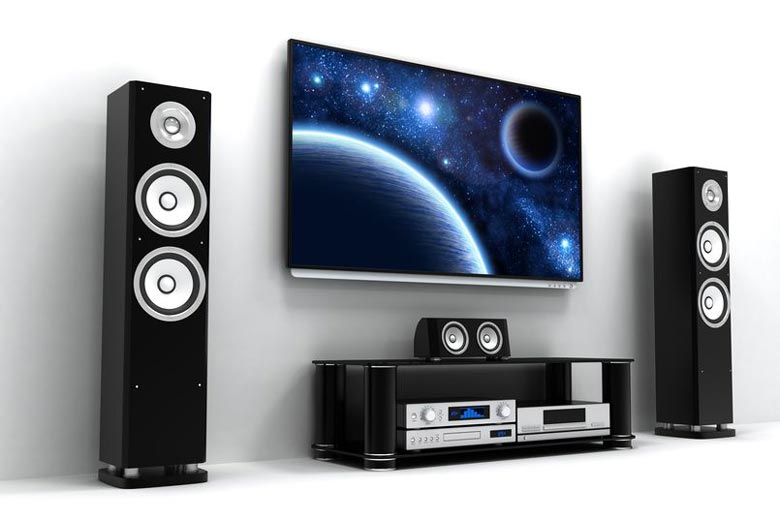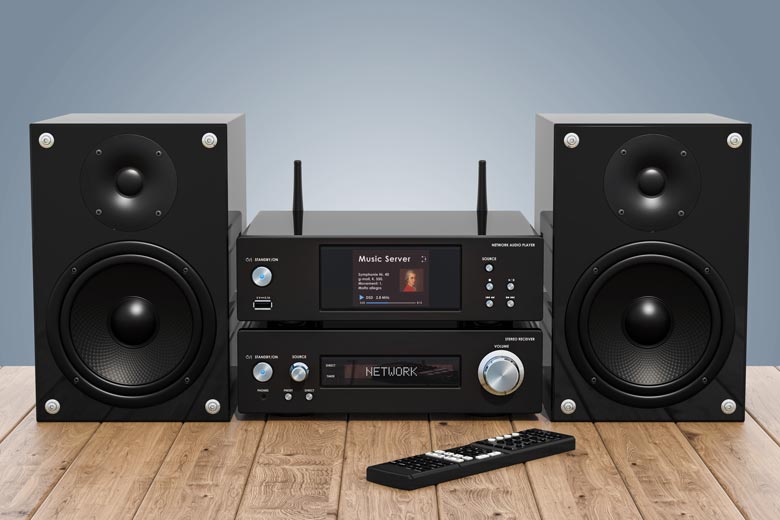The speakers that come in your TV or music player are probably not the highest standard and don’t give you the cleanest audio. You can supplement them with an external audio system, but how can you tell which kind is right for you?
The difference between home theaters and music systems is the number of channels and what the system is designed to play. Home theaters usually have five channels and surround sound for better movie experiences, while music systems have two channels and are focused on high-quality music audio.
Both systems will give you high-quality audio, but the kind of audio you’re listening to will help determine which system is right for you. Technically, you could use either type of system for any audio listening, but this article will help you find the system that will give you exactly what you need.
What Is a Home Theater System?
A home theater system is any sound system that is designed to connect to your TV and give you better sound quality when you’re watching TV or movies.
All home theater systems will have some sort of amplifier that will boost the sound signals from your TV and speakers that will play the sound.

There are a few different ways these systems work.
Some packages have separate components for the amplifier and the speakers, whereas others have a single soundbar that combines the speakers and amplifier into one unit.
Read more: Why Are Soundbars So Popular? 7 Reasons
You can also create your own home theater system with an amplifier and receiver and however many different speakers you want.

A good starter system is the Yamaha YHT-4950U Home Theater System, available on Amazon. It has separate speakers, with the receiver supporting Bluetooth. Installation and setup are easy enough for a beginner and the sound quality is great for the price.
You can, of course, get better audio from other home theater systems but you will have to spend a lot more. This is an excellent start!
Also Read: How To Set Up a Home Theater Surround Sound System
The Pros
Home theaters are meant to mimic the experience of sitting in a movie theater. The most obvious component of that is the surround sound setup.
Most home theaters will have five speakers (three in the front and two in the back) and one subwoofer. This arrangement is called 5.1 surround sound.
Movies and television have a lot of audio components that have to be in balance, including dialogue, background music, and sound effects.
A good home theater system will keep the sound levels appropriate so that you can hear all of the components.
The Cons
To get the best audio quality from a home theater system, you’ll need to create your own out of individual components or get a professional-quality boxed set, which can be expensive. Building your own can also be costly.
Moreover, even if you have a large budget, making your own system can be confusing.
Home theater systems also don’t have the best sound quality out of all the various sound systems. They are designed for movies, so listening to music through these systems won’t give you the best listening experience as compared to a home music system.
What Is a Music System?
A music system is a home stereo system designed to give you a high-fidelity listening experience for music specifically. Music systems typically use a 2.0 setup, meaning there are two speakers, one on the left and one on the right of the listener.
Some systems add a subwoofer and are considered 2.1 setups.

Home stereo receivers sometimes include CD players or radios and connectivity options for smartphones, laptops, or other wireless music players. Other systems don’t have music players built-in, and you’ll need to connect them to your music player separately.
A home music system is tailored to play music so that it sounds like you are in the room with the musicians. Unlike surround sound, all of the sound is coming from one direction. The receiver and the speakers are meant to give you the cleanest audio possible, without noise or interference.
Related article: Can an Amplifier Be Too Powerful for Speakers?

The Denon D-M41 (available on Amazon) is a simple but powerful Hi-Fi system for beginners who wants an affordable home stereo system. The surprisingly superb sound quality will stand up against many much more expensive music systems. The receiver has radio, CD, and USB capabilities built-in, which simplifies the installation process. It also has wireless connectivity for a broader range of devices.
For a superb listening experience, you will have to spend more money than this though.
The Pros
If your goal is crystal-clear audio that sounds just like a live performance, then a music system is your best bet.
Professional-grade systems also give you more control over your playback settings, with equalizer and balance options that you can adjust based on the type of music you’re listening to and your personal preferences.
Music systems are also more compact than home theater systems as they have fewer components. This also makes them easier to install and set up in your home, which lets you focus on the audio quality over all else.
The Cons
If you want your home sound system to do double duty for both television and music listening, you may not be satisfied with a home stereo system. With adapters and converters, it is possible to connect most any output device to most any source, so you could hook your stereo up to your TV to play the sound.
It won’t give you the same effect as a home theater system, however.
As with home theater systems, home stereo systems can be expensive too. Make sure when you select your system that you choose one that’s versatile, or you may find that listening technology leaves your system behind.
It’s hard to predict the future of technology, which could mean that an investment in a system now could be useless down the road.
A high-quality system from the 1980s that is built to connect to a record player might be in perfect working order, but if you can’t connect it to your smartphone, too, you may be frustrated by it today. A flexible and versatile system can potentially help you avoid this pitfall.
Which System Should You Choose?
When picking between a home theater and a home stereo system, you should consider your priorities, the size of your space, and what your primary use for the system will be.
If you’re using your audio system in a very small room, a 5.1 system might be too much for the space. Alternately, a large area might be too much for a 2.0 or even a 2.1 system.
You could also use both a home theater system and a home stereo system if you have dedicated spaces for each or don’t mind switching between outputs between activities. However, for general use, a home theater system is better than a stereo system.
A home theater system can give you decent audio quality for music listening, but a stereo system will give you a less satisfactory experience for watching a movie.
If you don’t need a sound system for watching TV and movies, then a stereo system is likely to be a more affordable option that can meet your needs.
Also Read: Can You Connect Hi-Fi Speakers to a TV?
Conclusion
Home stereo systems and home theater systems are two different ways to bring high-quality audio into your home. The primary difference between the two is the number of channels. Each one is tailored to a specific purpose, but they will do an adequate job of replacing each other.
Home theater systems are built for surround sound and the complex sound layers of movies. Stereo systems are more committed to clean, high-fidelity audio quality and usually use only two channels.
Both come in a range of prices, and you can find a ready-made system or create your own from separate components.